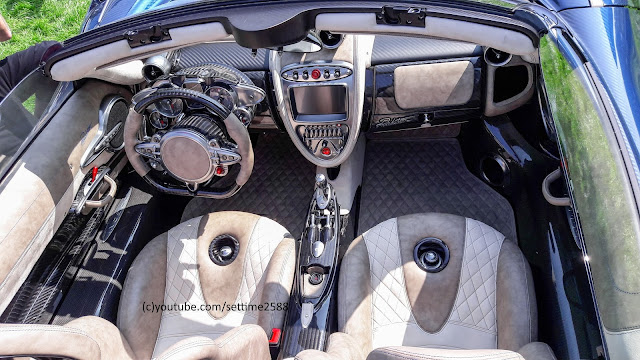Interior of a Pagani Huayra Roadster seen at Cars & Coffee 2017. Brescia, Italy
Interior of a Pagani Huayra Roadster seen at Cars & Coffee 2017. Brescia, Italy
Many videos shot at this event are on my channel www.youtube.com/settime2588
Here is the Full Playlist of the Event
Huayra Roadster
After 2 years of development, the Huayra Roadster was officially unveiled in the 2017 Geneva Motor Show.
The appearance of the car has changed, with the most obvious being the open top (hence the Roadster name). This part of the vehicle is also its key element. The design of the rear changes, with new eyelid-like fixed flaps that continue with the design and eventually end on the rear lights. The rear engine hood also has a new shape to adapt to the roadster form. It also, unlike the Coupe, does not include a black carbon-fiber stripe across it. The engine hood also now has grilles. The wheels also change, with a new set specifically constructed for the Roadster model. There is now also a front spoiler. The doors are no longer gull-wings, as this is a convertible version of the Huayra.
The vehicle still runs on the same M158 V12, but now has a total of 764 PS (562 kW; 754 hp) at 6200 rpm and 1,000 N·m (740 lb·ft) of torque at 2400 rpm. All of this power is delivered to the rear wheels via an all-new 7-speed automatic manual transmission by Xtrac. The car now uses a hydraulic and electronic activation system with carbon synchronizers. Bosch have also done some help for the Roadster, constructing ECUs and electronic differentials for it, giving it increased drivability. The entire system weighs 40% less than the gearbox. The weight is now 70 kilograms lighter, for a total of 1,280 kg (2,820 lb), making the first roadster lighter than the coupe version. There will be only 100 Huayra Roadsters made and all of them have already been sold. The tire supplier is Pirelli, with P-Zero tires. The tires have a white narrow outline, resembling the F1 race car tire lines. Pagani has also used a new material for the Roadster called carbon triax, which is a tri-axis fiberglass meshed with carbon-fiber power bands.
Pagani says the car can do 820 kilograms (1,800 lb) or 1.8 lateral G-forces during acceleration. However, this figure is unproven, but if true, Pagani will have set a new record.




Comments
Post a Comment